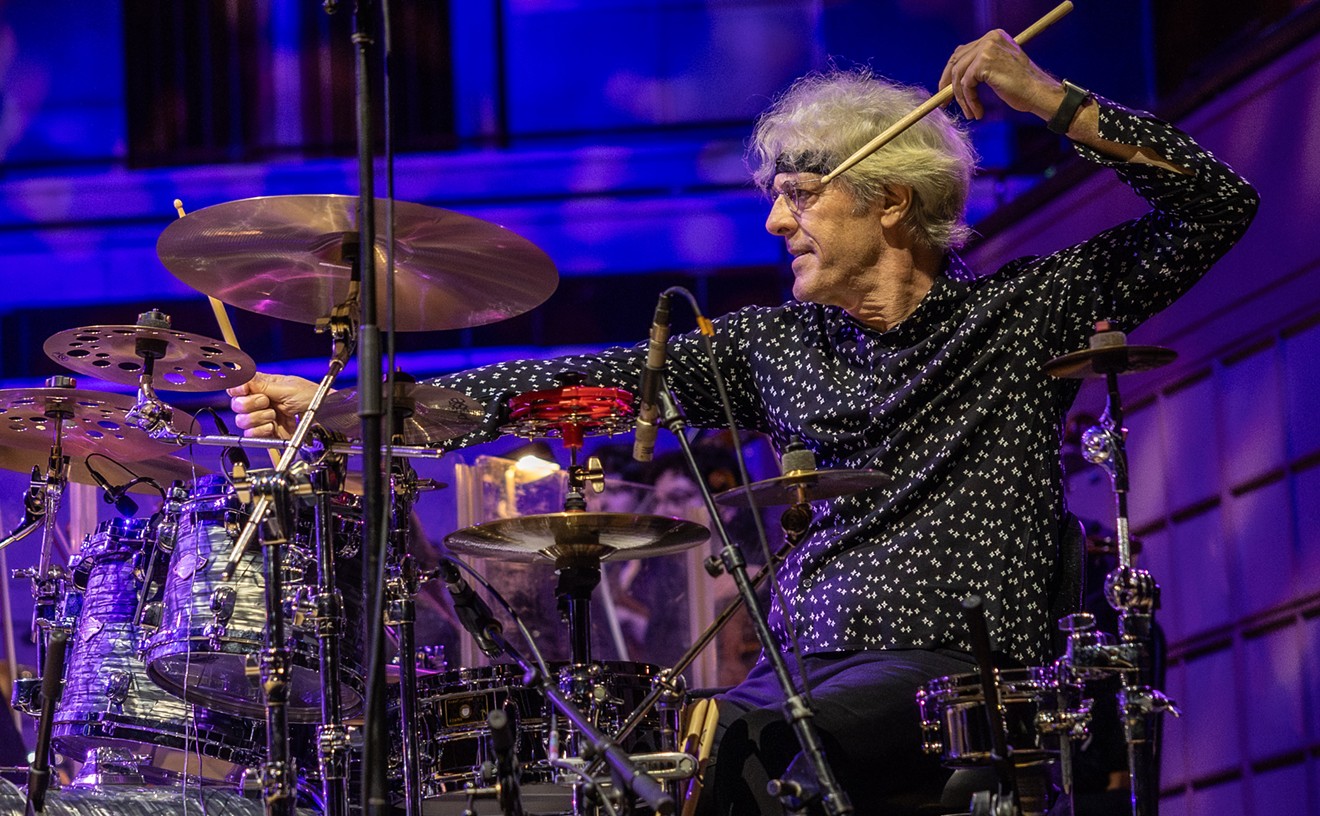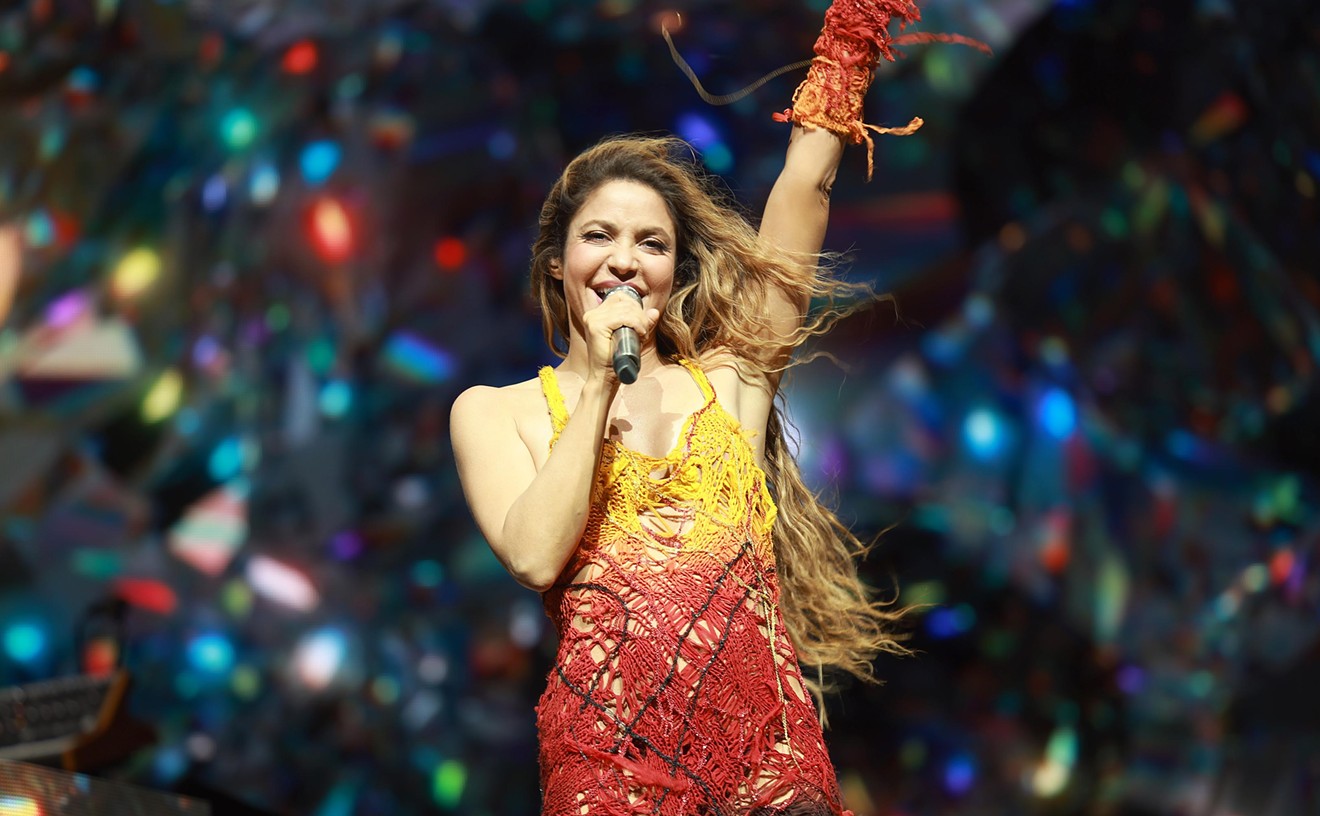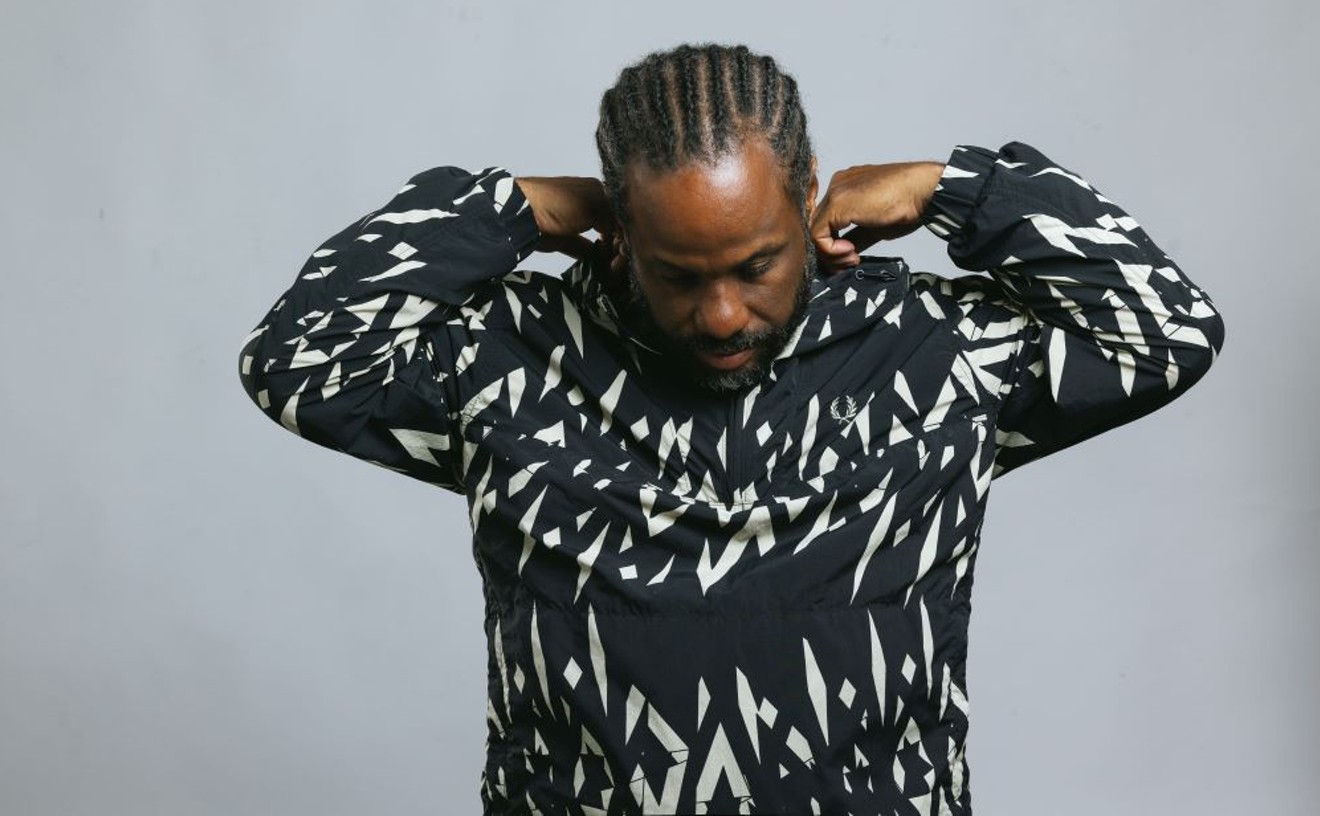"A lot of people wonder who he is," says the son of the man in that picture. "But they have no way of finding out his name. Nobody mentions him. Ever." The son laughs as he often does when talking about why his father isn't famous, even though he probably ought to be. Or, if not famous, at least not forgotten.
The son's name is Von Babasin. His father's name was Harry Babasin, and he was a jazz bassist for some 50 years, before his death in 1988 from emphysema. Actually, the Dallas-born Babasin wasn't just a bassist, some hump schlepping his instrument from gig to gig, checking his watch and working on the clock. The man they called "The Bear" wasn't some nobody slapping his shit in the shadow of towering giants. Harry Babasin played with the famous and the beloved. He was their peer, their bandmate, their friend. And, if one is to believe the calendar, he played bossa nova when it was still an infant, not a craze credited to Stan Getz, Joao Gilberto, and Antonio Carlos Jobim when the three released Getz/Gilberto in 1963. Babasin played on and contributed a song ("Noctambulism") to guitarist Laurindo Almeida's Brazilliance Vol. 1--recorded a full decade earlier. Babasin also was the first jazzer to solo on the cello--not a small claim to fame, especially if you know who Oscar Pettiford is.
Babasin's résumé is filled with the names of men and women who fill pages and pages of the history books. Poor Harry barely warrants a sentence, if he's that lucky. He toured and recorded with the likes of Benny Goodman, Louis Armstrong, Mel Torme, Charlie Barnet, Gene Krupa, Billy Eckstine, Peggy Lee, Dinah Shore, June Christy, and, yeah, Charlie Parker and Chet Baker. The night that photo was taken, June 16, 1952, the two of them were guests in his club, the Trade Winds in Inglewood, California, a suburb of Los Angeles. The two of them needed a place to play, and they called Harry. Once, a long time ago, everybody did.
But history has treated Harry Babasin poorly. It has erased him from its memory. In his early jazz encyclopedias, influential critic Leonard Feather gave Babasin a good chunk of space; later, his entry would shrink to the size of a postage stamp--a few words, scant biographical information, little else. It's a hell of a way to treat a "pioneer," as Feather referred to Babasin. But it's to be expected, perhaps: Von Babasin says his father once told Feather, during his playing days, that he wasn't very good. Von believes Feather got his revenge by writing his dad out of jazz's past. But he wasn't the first or last: According to Von, his father produced Julie London's enormous hit "Cry Me a River," but received neither credit nor payment. It was as though he was never there.
Von, himself a 45-year-old jazzer living in Studio City, California, has made it his life's mission to correct that: He has posted a biography of his father to a Web site (www.onoffon.com/harrythebear.html), and only last week, Von sent an e-mail to Casey Monahan, director of the Texas Music Office, hoping to rectify an injustice. The TMO has long listed Harry Babasin as a Texas-born musical pioneer, without mentioning who he was or what he accomplished in his lifetime.
Two years ago, Von also oversaw the release of a three-disc boxed set, The Complete Nocturne Recordings, commemorating the label his father started and owned in the mid-1950s. But it still is an incomplete collection: Von estimates there are more than 500 hours of unreleased music still sitting on the shelf, begging to be restored, remastered, and released. But he can ill afford such a venture: There exists on the market only a handful of his father's recordings, and Von and his mother receive royalty checks barely worth the paper on which they are printed. He did not know till last week that the English label Charly Records rereleased in 1996 the CD "Live" at the Trade Winds, featuring his father with Parker and Baker. And there are labels in Europe and Japan that have released Harry Babasin material, without paying up.
Still, bit by bit, Von and his mother, Barbara, chisel away at history's ignorance of Harry Babasin.
"It does hurt," Von says of the lack of recognition accorded his father. "The family kinda laughs about it, because we have to, but when I see these books and Stan Getz and Jobim credited for the bossa nova when Dad and Laurindo met in 1953 and experimented with that then. It's frustrating. Everyone thinks Oscar Pettiford was the first to play pizzicato jazz cello. I don't want to feel like I'm trying to steal other people's accomplishments. They were all talented people, and who was the first one to pick up the cello is neither here nor there. But I just want to get him mentioned."
On March 19, 1921, Harry Babasin was born in Dallas only because his mother wanted to have her son in a "classy hospital," Babasin told International Musician in 1982. Harry's father, Yervant Harry Babasinian, was an Armenian immigrant who had come to Texas in 1915. Soon after arriving, he met Minnette Turner, a music teacher from Vernon, where the family lived. She taught her boy how to play: Harry picked up bassoon, cello, piano, bass, even tuba during his short stint at Texas A&M during the late 1930s. He once told an interviewer he "was a bandleader's dream because I could read music."
After A&M, he enrolled at what was then called North Texas Teachers College in Denton, which is now the University of North Texas. There, he fell in with the jazzers: Herb Ellis, a guitarist out of Farmersville; Dallas-born sax player Jimmy Giuffre, who would go on to join Woody Herman's band in 1949; and Gene Rolands, a Dallas-born multi-instrumentalist and composer whose own résumé includes stints with Lionel Hampton, Dizzy Gillespie, Zoot Simms, and Stan Getz. "We were among the best musicians on campus," Babasin told International Musician, without a trace of humility. Babasin and Ellis left North Texas together: The two had gone to Fort Worth for a performance by the Charlie Fisk Orchestra and told the bandleader they were better than anyone else in the band. Their arrogance was not unwarranted: Babasin and Ellis got jobs with Fisk. But their tenure was short-lived. The band folded three months later, in the middle of the Midwest nowhere.
Babasin latched on with the Jimmy Joy Orchestra, a dance band based out of Chicago. But he was itching to escape the Midwest, and he seized his opportunity to move to New York by hooking up with the Bob Strong Orchestra. The move to Manhattan proved monumental: With war raging in Europe, there was a scarcity of bassists, and Babasin had his pick of jobs. He eventually got work with Boyd Raeburn, female trumpet player Billy Rogers, the Dardanelle Trio, and Johnny Richards' band.
It was during his stint with Richards that Babasin met drummer Roy Harte, who would later go on to play on such hits as Tennessee Ernie Ford's "Sixteen Tons" and Ella Mae Morse's "Cow Cow Boogie." The two became inseparable: When one guy got a job with a band, he demanded the other be hired on as well. By 1946, they both landed in Los Angeles: Babasin had gone out with Benny Goodman's band; Harte, with Lucky Millinder's band, which swung so hard just listening to it could throw out a man's back.
"We couldn't go further without getting wet," Harte says from his office in Los Angeles. "We liked the weather. We'd had enough of snow. We were great friends from the moment we met. He had the musical genius that astounded me, and I had the patience of Job. That was his phrase. He had a Texas temper and temperament, and I overlooked it. A lot of people didn't. One reason why we didn't get well-known was that Harry spoke his mind, and it got in the way. I was just afraid of this big, bear-like guy. He could knock you over with a breath."
Babasin recorded a great deal with his old boss Boyd Raeburn (a 1946 L.A. recording of "Dalvatore Sally" appears on the boxed set Big Band Renaissance, issued in 1995 by the Smithsonian Institute) and Goodman, after the bandleader left Columbia Records for Capitol. As the bassist told International Musician, Goodman was often in the studio once he moved to L.A., trying to build an extensive library for his new label. A year after moving to Hollywood, Babasin met Dodo Marmarosa, one of the greatest pianists of the bop era; he recorded with the likes of Parker (during his legendary Dial period) and Lester Young. In 1947, Babasin joined Marmarosa's trio--but as cellist, not as bassist. He had gotten the idea from Charlie Barnet, who heard him toy with a prop cello on the set of a movie the two were filming. It stuck, and Babasin was the first man to record cello solos in a jazz setting.
"During the ensuing years, while very busy as a bassist in the Hollywood studios, I continued picking the cello in hobby and at sessions," Babasin wrote in the July 10, 1958, issue of Downbeat, "becoming more and more convinced of the possibilities of the pizzicato cello as a jazz solo voice." In 1953, he and Pettiford--Babasin's "long-time friend and idol," he wrote--even recorded some cello duets, which were eventually released on Imperial Records. They are impossible to find today. By the mid-1950s, Babasin would form a band built around nothing but cello, guitar, and bass (and, later, drums); he called his band the Jazzpickers, and he was Chief Jazzpicker.
Released in 1948, director Howard Hawks' screwball comedy-cum-musical A Song is Born, featured a host of jazz all-stars alongside stars Danny Kaye and Virginia Mayo. Babasin appeared along with Goodman, Barnet, Louis Armstrong, Tommy Dorsey, Charlie Barnet, and myriad other jazz all-stars. The movie was perhaps the most significant event of Babasin's life: Not only had he picked up the cello at Barnet's insistence, but he also met the Brazilian guitarist Laurindo Almeida, with whom he would cut the first bossa nova recordings a few years later. Almeida was, at the time, nothing but an extra. But by 1962, Downbeat was referring to Babasin and Almeida as the fathers of bossa nova--the first men to experiment with grafting "the Brazilian baiao rhythm and modern jazz." The magazine called the music Babasin's "brainchild."
But that was a few years off--after the studio gigs, the TV work, the movies. In Hollywood, Babasin started picking up studio work, backing up the likes of Dinah Shore, Frank DeVol (who made his name composing themes for such television shows as The Brady Bunch and My Three Sons), and Mel Torme. (One dynamite 1949 recording with Torme, "The Four Winds and the Seven Seas," can be found on Rhino Records' 1996 The Mel Torme Collection boxed set.) By the early 1950s, Babasin began running regular jam sessions at the Trade Winds, described in Ted Gioia's book West Coast Jazz as "a fairly undistinguished suburban nightspot with a pseudo-Polynesian décor."
Everyone stopped at the Trade Winds; it became the West Coast Birdland, a home-away-from for the boys from New York City. Drummer Bob Andrews was wise enough to record as many of the gigs as possible. Without him, there would be no document of the night of June 16, 1952, when Charlie Parker and Chet Baker stopped in. Released finally in 1991, the "Live" at the Trade Winds CD (also known as Inglewood Jam, depending upon the label), is a thrilling listen--the sound of legends and soon-to-be heroes flying without a net, playing only for themselves.
"When we first met Bird, we were working club dates in New York," Roy Harte says. "Charlie was at the Downbeat on 52nd Street, Diz was playing with Bird, and we got to sit in. They liked us. We were two young white fellas that played a little black. It was very exciting. Those guys came into town and changed everything. At the Trade Winds, Harry had the job of hosting the jam sessions every Monday night. It was their slowest day, and he picked the men to play. All our friends that were traveling didn't have a place to play, so they called us, and we told them they could play. We tried to tape it as much as possible, which is how the "Live" at the Trade Winds CD came about. It was exciting. It was Chettie Baker's first job. I mean, on that album with Charlie Parker, that's his first record! Many other firsts happened out of the Trade Winds, and that was all Harry's doing. He was quite a force in Hollywood jazz."
In June 1952, Roy Harte and partner Remo Belli, another drummer, opened Drum City on Santa Monica Boulevard; out of that space, he also ran his own label, Pacific Jazz, and gave office space to the West Coast editor of Downbeat magazine. Two years later, Harte and old pal Babasin formed their own label, Nocturne Records: Harte ran the business, while Babasin was the label's musical director (he would appear on most of the label's recordings).
Babasin told Down Beat that year that a "new school of jazz" had taken hold in Hollywood, and he wanted to record his friends--capture their magic, before it evaporated like the morning fog that rolled in from Santa Monica. He gave albums to men who had never before been bandleaders--among them trombonist Herbie Harper, flautist and sax player Bud Shank, horn player Bob Enevoldsen, and pianist Jimmy Rowles--and he allowed them the ultimate freedom: Record what you want, and own what you record. Nocturne would release the albums as part of its "Jazz in Hollywood" series, but the artists had control of the masters. Such an arrangement was almost unheard of at the time. And such an arrangement killed Nocturne: The label lasted only one year. Babasin declared bankruptcy, sold his home in the Hollywood Hills, and moved to the suburbs.
"But still Harry and I kept recording, even though it didn't get released," Harte says. "What you get on that Nocturne Recordings package is what was released, and the rest is still on the shelves. We had more fun playing it and recording it than we did releasing it. It was too much trouble dealing with the major companies."
Babasin kept working throughout the 1950s--recording and releasing one album with the Jazzpickers, which has been reissued on CD, though actually attaining a copy is damned near impossible--and the 1960s, but his heyday had come and gone. Rock and roll was all the rage on the West Coast; jazzers, especially those who had come of age during the eras of swing and bop, were left to sink in the La Brea Tar Pits, with all the other dinosaurs. In 1974, Babasin found a new home as director of the Los Angeles Theaseum and its Jazz Chronicles workshop, a non-profit archive of West Coast jazz history, Von explains. Babasin wouldn't play much after that; instead, he tried to cajole old jazzers out of retirement while using National Endowment for the Arts grants to clean up vestigial jazz recordings that were beginning to crumble into dust.
In 1985, he went on his last tour with pianist John Bannister, but the comeback was short-lived: Babasin was diagnosed with emphysema, and he died three years later. If there was an obituary in the Los Angeles Times, it does not turn up in computer searches of the newspaper's archives.
Von and Roy Harte have their suspicions why Harry is ill-remembered by history: He liked to write articles defending West Coast jazz, insisting it was every bit as legit as the music being played back in New York. He was a loud-mouth in the best sense of the word--The Bear, forever roaring. Even if it meant he and his pals would get shut out by the so-called gatekeepers. Historians might treat them poorly, but they'll always have their music to prove their point: They were here, and they were brilliant.
"It bothers me we were kept out of the history books, but all our friends are in them," Harte says, chuckling. "Shorty Rogers and all those guys made the history books, so we felt like we made them too. That wasn't our aim. We didn't aim to make a name for ourselves. I do feel a little left out, but it will come out. I don't have to be around for that. We were the first bossa nova rhythm section, and nobody knows that. So what? In the long run, it's not important who gets credit."
Harte is asked if he is serious. He pauses for a moment, then lets out a deep breath and a loud laugh.
"OK, you're right. It is important. I'll stop the B.S. But I was and am too busy to let myself be let down by that. There will always be someone who appreciates us, and that's all that matters in the end. That's it."










